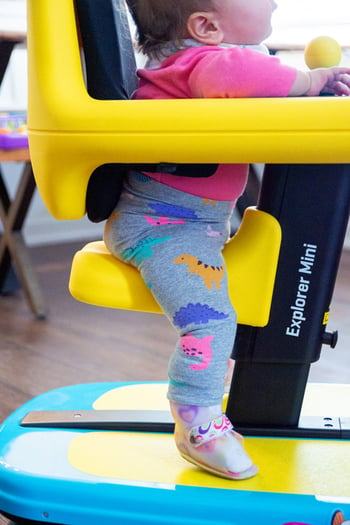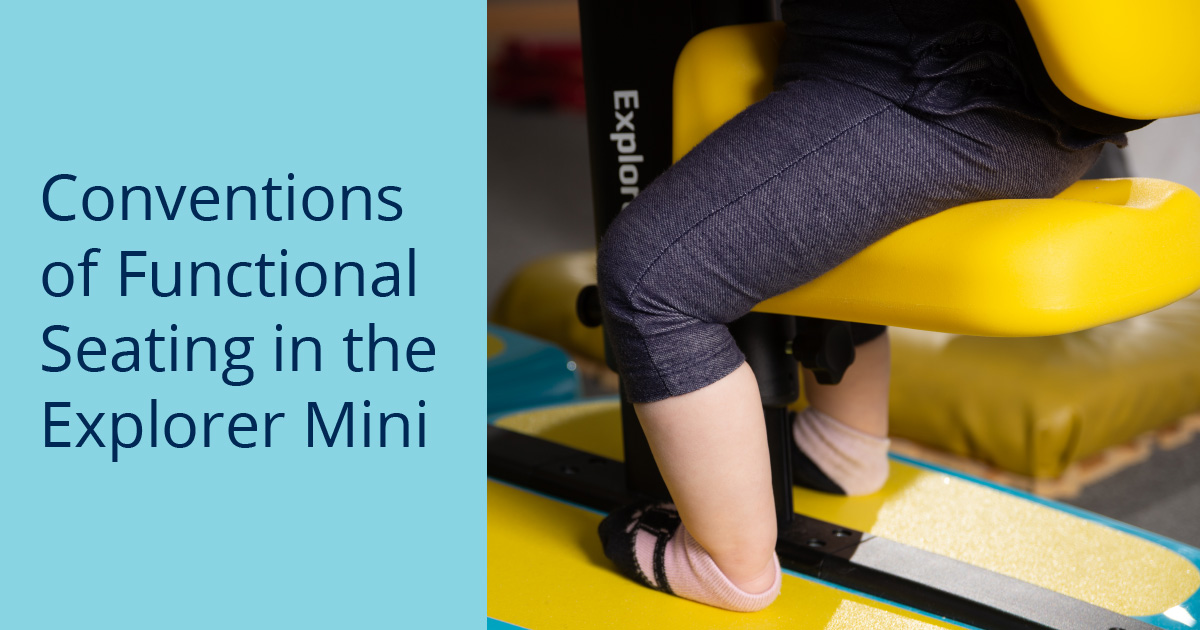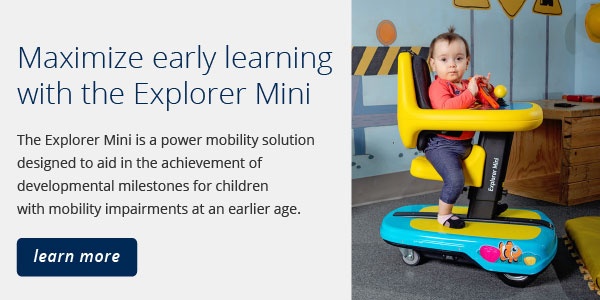Part 10 in our series about developmental milestones in early childhood focusing on mobility. See part 1, part 2, part 3, part 4, part 5, part 6, part 7, part 8, part 9, part 11, and part 12. Learn more about the Explorer Mini here.
We can find all sorts of ways to sit, usually not always the most optimal but we change our positions based on the task we are performing. Reading a book, maybe our legs are propped on the couch, or we sit cross legged. If engaged in writing or typing we are probably resting our feet on the floor, leaning slightly forward and resting our hands on the desk or chair supports. A young child with delayed milestones or mobility impairments cannot access those alternative positions. They are dominated by gravity. If they have not had opportunities to meet the developmental milestones in incremental order, their posture will be affected, therefore the task they perform will be altered.
If you think about how a young child develops trunk and head control, it’s logical to think about ways to correct that. If the child is unable to do so themselves, they will need postural support. In order for a young child to begin using their arms and hands they need first to control their core muscles. This is why a pre-crawling infant will spend a lot of time rocking back and forth when on all fours. This movement around the joint strengthens the joint capsule—where the muscles attach—to help build muscle strength and endurance.
How does the Explorer Mini provide functional seating?
The Explorer Mini is designed for the non-ambulatory and the emerging ambulator. It provides the developmentally appropriate supports to establish an upright trunk. We call this sequence of movements and postures the “conventions of functional seating”. In this case function means whatever that young child would be doing at that stage of their development.
The elements of functional seating: One must have a stable base of support on the buttocks and thighs. In order to prevent a slumping posture, the pelvis needs to be tilted forward.
When we typically visualize a child with mobility impairments in “functional seating”, we think of them in a wheelchair with a cushion, back support, head support, and maybe even lateral trunk supports. It’s easy to assume that all these supports are required to provide stability for function. This may be true, but the supports don’t encourage the strengthening of core muscles or activation of the trunk muscles for posture, head control, and ultimately functional use of the hands.

There is now an option with the Explorer Mini to put young children in a posture of functional seating that will place the pelvis in a forward position for stability, with feet directly underneath. The forearms provide added stability by weightbearing on the tray, triggering the trunk muscles to activate and extend, which encourages an upright head. By allowing freedom of movement through intentionally not using straps or belts, young children can safely work to bring themselves into a functional seating posture. Although the Explorer Mini is not intended for full time use, it is a device that can be used intermittently and help a very young child develop a functional upright posture, with the reward being intentional, self-initiated movement to explore their environment.
 Dr Teresa Plummer, PhD, OTR/L, ATP, CEAS, CAPS
Dr Teresa Plummer, PhD, OTR/L, ATP, CEAS, CAPS
Associate Professor in the School of Occupational Therapy at Belmont University
Dr Teresa Plummer, PhD, OTR/L, ATP, CEAS, CAPS is an Associate Professor in the School of Occupational Therapy at Belmont University in Nashville, TN. She has over 40 yrs of OT experience and 20 in the area of Assistive Technology. She is a member of the International Society of Wheelchair Providers, and the Clinicians Task Force. She is a reviewer for American Journal of OT and guest reviewer for many other journals. She has presented internationally, nationally and regionally particularly in the area of pediatric power mobility. She has authored journal articles and textbook chapters in the area of OT and pediatric mobility and access.

